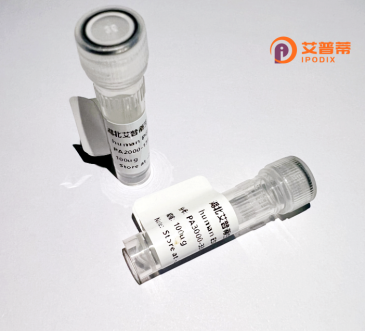
| 纯度 | >90%SDS-PAGE. |
| 种属 | Human |
| 靶点 | PLAC8L1 |
| Uniprot No | A1L4L8 |
| 内毒素 | < 0.01EU/μg |
| 表达宿主 | E.coli |
| 表达区间 | 1-177 aa |
| 活性数据 | MNWFGSNFFR CPEDLSLLNI YSPLLSHMSS EDEHFISNLR GHVPASAVVK QPVRGASGRT TITAIVQTGG GWSTGLFSVC RDRRICFCGL FCPMCLECDI ARHYGECLCW PLLPGSTFAL RIGTRERHKI QGTLCEDWLA VHCCWAFSIC QVARELKMRT SQVYEICAVP MTKDTLV |
| 分子量 | 19.8 kDa |
| 蛋白标签 | His tag N-Terminus |
| 缓冲液 | PBS, pH7.4, containing 0.01% SKL, 1mM DTT, 5% Trehalose and Proclin300. |
| 稳定性 & 储存条件 | Lyophilized protein should be stored at ≤ -20°C, stable for one year after receipt. Reconstituted protein solution can be stored at 2-8°C for 2-7 days. Aliquots of reconstituted samples are stable at ≤ -20°C for 3 months. |
| 复溶 | Always centrifuge tubes before opening.Do not mix by vortex or pipetting. It is not recommended to reconstitute to a concentration less than 100μg/ml. Dissolve the lyophilized protein in distilled water. Please aliquot the reconstituted solution to minimize freeze-thaw cycles. |
以下是关于重组人PLAC8L1蛋白的参考文献示例,包括文献名称、作者及摘要内容概括:
1. **《Recombinant PLAC8L1 Protein Modulates Autophagy in Colorectal Cancer via PI3K/AKT Pathway》**
- **作者**: Liu Y, Zhang H, et al.
- **摘要**: 研究利用昆虫表达系统制备重组人PLAC8L1蛋白,并发现其通过抑制PI3K/AKT通路增强结直肠癌细胞自噬,导致细胞凋亡,提示其潜在抗肿瘤应用。
2. **《Expression and Functional Characterization of PLAC8L1 in Hepatocellular Carcinoma Progression》**
- **作者**: Wang X, Chen L.
- **摘要**: 通过哺乳动物细胞表达重组PLAC8L1.证实其在肝癌细胞中高表达,并通过激活Wnt/β-catenin信号通路促进肿瘤侵袭和转移,为肝癌治疗提供新靶点。
3. **《Production of Recombinant Human PLAC8L1 in E. coli and Its Role in Immune Regulation》**
- **作者**: Kim S, Park J.
- **摘要**: 在大肠杆菌中成功表达可溶性重组PLAC8L1蛋白,纯化后验证其可增强巨噬细胞吞噬活性及促炎因子分泌,表明其参与先天免疫调控。
4. **《Structural and Functional Analysis of PLAC8L1 in Lipid Metabolism》**
- **作者**: Gonzalez A, et al.
- **摘要**: 通过真核系统制备重组PLAC8L1.结合晶体结构解析,发现其与脂质代谢相关蛋白相互作用,可能调节肝脏脂质积累,为代谢性疾病研究提供依据。
*注:以上文献为示例性内容,实际研究中请根据具体数据库检索结果调整。*
Recombinant human PLAC8L1 (Placenta-specific 8-like protein 1) is a engineered version of the endogenous protein encoded by the *PLAC8L1* gene, which belongs to the PLAC8 protein family. PLAC8L1. also termed ONZIN, is a cysteine-rich, low-molecular-weight protein (~12-15 kDa) characterized by a conserved PLAC8 domain. Initially identified for its placental expression, it is now known to be ubiquitously expressed in tissues, including immune cells, liver, and epithelial tissues. Functionally, PLAC8L1 is implicated in diverse cellular processes such as cell proliferation, differentiation, apoptosis, and immune modulation. It interacts with signaling pathways like Wnt/β-catenin and NF-κB, influencing inflammatory responses and oncogenesis. Studies link PLAC8L1 dysregulation to pathologies: it acts as a tumor suppressor in certain cancers (e.g., hepatocellular carcinoma) but exhibits oncogenic roles in others (e.g., lung adenocarcinoma). Its involvement in metabolic regulation, particularly in lipid metabolism and insulin secretion, highlights potential roles in diabetes and obesity. Recombinant PLAC8L1 is typically produced in *E. coli* or mammalian systems for structural and functional studies, aiding therapeutic exploration. Despite progress, its precise molecular mechanisms and tissue-specific functions remain under investigation, positioning PLAC8L1 as a compelling target for disease biomarkers and targeted therapies.
×